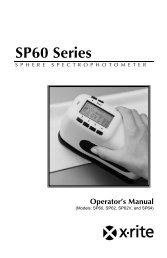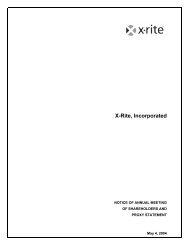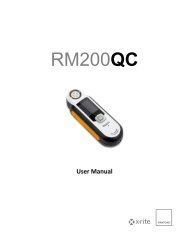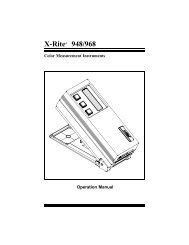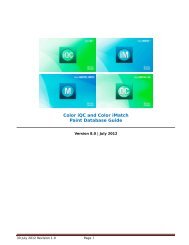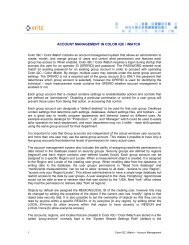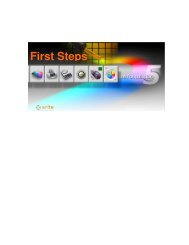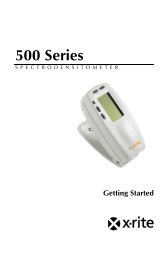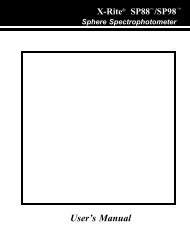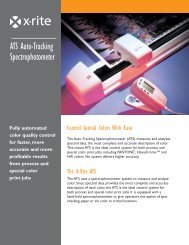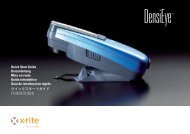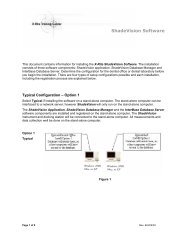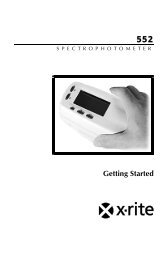Schwan-STABILO Cosmetics Case Study - X-Rite
Schwan-STABILO Cosmetics Case Study - X-Rite
Schwan-STABILO Cosmetics Case Study - X-Rite
Create successful ePaper yourself
Turn your PDF publications into a flip-book with our unique Google optimized e-Paper software.
<strong>Schwan</strong>-<strong>STABILO</strong> <strong>Cosmetics</strong> <strong>Case</strong> <strong>Study</strong>Some of the world’s largest corporations such as <strong>Schwan</strong> – Stabilo <strong>Cosmetics</strong>,Wal-Mart, Target Corp., General Motors Corp are imposing tougher standards onsuppliers to ensure that their employees who are responsible for color quality controlcan discriminate between various shades of color. Suppliers in industries as varied ascosmetics, textile dyeing, plastic injection molding and printing are working to meetthe higher standards required by major corporations that want to improve customersatisfaction, reduce waste and cut the time it takes to bring new products to market.In the past, suppliers have improved the system of colorcommunications largely by concentrating on the hardwareused to communicate color standards, such asspectrophotometers that measure how closely colors matchstandards and light booths that provide standardillumination. But to achieve the requirements of the newstandards, suppliers now need to address the human sideof color perception. Companies are being asked to gaugewhether the individuals they employ in such occupationsas quality control personnel, printing press operators,chemists, and soft goods buyers have the appropriate levelof color vision to perform their duties properly.Deficiencies in color vision are much more prevalent thanmost people imagine: nearly one in every 12 males hassome form of color vision defect. In addition, a numberof factors can diminish a person’s ability to distinguishbetween colors and shades, such as:• Increasing age that causes discoloration of the lensand cornea• Stress that increases blood pressure• Certain medications• Diseases• Overexposure to ultraviolet light from daylightIn many instances, individual aren’t even aware of theirlimitations in discriminating colors and subtle shades untilexpensive mistakes occur on the production line, in theshipping department or when placing large orders fromsamples. The result of poor color vision can be shippingxrite.com
delays, returned goods, products made out-of-specificationand customer complaints. Some industries where poorcolor discrimination can be particularly costly includes:• Design, Fashion, Graphics, Interior, and Product• Printing and Packaging• Plastic manufacturing – Color Concentrationand Molding• Coating, Paints, and Inks• Architectural Paint• Textile Dyeing and Processing• <strong>Cosmetics</strong>Fortunately, companies can use a quick, inexpensive andeffective test to accurately determine whether an individualis well suited for an occupation that requires sharp color vision.X-<strong>Rite</strong>, the world’s largest manufacturer and designerof color measurement equipment and software solutions,offers the Farnsworth-Munsell 100-Hue Test that has beenused for more than 60 years to distinguish between individualswho have poor, normal, orexceptional color vision. One of the most widely usedtests in industries where color control is essential, the FM100 Hue test is also used to detect medical conditions suchas ocular disease, diabetes and Parkinson’s disease.“Over the last five years, our unit sales of the FM 100 Huetest have essentially doubled as companies have reacted todemands for better color communication,” X-<strong>Rite</strong> ProductManager Art Schmehling said. “They see the FM Hue testas a cost-effective method to meet more stringent ISO andQS standards.” Major corporations have been quick todirect vendors all along the supply chain to implement thetest because it costs less than $800 for a kit. Due to itsrelatively low price, ease of use and accuracy, the test hasbecome a standard for color vision assessment in a numberof industries.One customer of the FM 100 Hue test is <strong>Schwan</strong>-<strong>STABILO</strong><strong>Cosmetics</strong> GMBH & Co., the leading private labelmanufacturer of cosmetic pencils worldwide. “In ourCOLOUR COSMETICS line, <strong>Schwan</strong> offers more than10,000 colors and more than 200 textures that cover everypossible cosmetics use,” said Heidrun Crim, R&D CosmeticPencils at <strong>Schwan</strong> based in Heroldsberg, Germany. “Tomanufacture such a vast assortment of products, we haveput into place rigorous processes to maintain our highquality standards in producing accurate and consistentcolors.” The FM 100 Hue test is one way that <strong>Schwan</strong>makes sure the exact colors of eye shadows match lipsticksthat have been produced over fashion seasons.While it has become a widely used tool for leadingcompanies, the FM 100 Hue test also has been specified bythe following standards:• ASTM 1499-97 Standard guide for the selection,evaluation and training of observers• ASTM 1729-96 Standard practice for visual appraisalof colors and color differences of diffusely-illuminatedopaque materials• AATCC EP9-2002 Visual assessment of colordifferences of textiles• SPI PB-1 Visual evaluation of reflected color• SAE J361 Procedure for visual evaluation of interiorand exterior automotive trim• TAPPI T515 Visual grading and color matchingof paperIndividuals being assessed for color vision often can completethe FM 100 Hue test in less than 20 minutes, anda person can be trained on how to administer the test inabout 5 -10 min. Because the test is quick andeffective, companies will often test their employeesannually to assess whether their sense of colordiscrimination has changed over time.Simplicity is a hallmark of the FM 100 Hue test. Theperson administering the test gives the participant fourtrays holding a total of 85 color chips in random order.The chips have different hues, but identical lightness andchroma values. The object of the test is for the participantto arrange the chips in proper order by hue. The misplaced
chips are counted, with lower scores signifying betterability to discern color differences.The results essentially tell the company two things:whether the participant has normal color vision and wherethe color discrimination issues are for the individuals. Forthose participants who have color vision defects, the testindicates where the color confusion lies, such as aweakness in perceiving red or green colors.While the basic test has been relatively unchanged since itsinception, X-<strong>Rite</strong> has made the administration of the testand resultant data gathering easy through use ofsoftware that is compatible with multiple operatingsystems. Translated in a number of languages, thesoftware allows for great flexibility in the way data isstored, retrieved and output. Every FM 100 Hue testreceives a certification label that confirms that the testhas been inspected and approved under X-<strong>Rite</strong>’s qualitypractices.“While it takes a little more effort, companies that raise thebar on color communications are differentiating themselvesfrom companies that have loose control over how theirproducts look to the public,” Schmehling said. “Overall,tools like the FM Hue 100 test help a company to keep itscompetitive advantage at a time when consumers are moredemanding about the colors of the products that theypurchase.”X-<strong>Rite</strong> World HeadquartersGrand Rapids, Michigan USA • (800) 248-9748 • +1 616 803 2100 • xrite.com© 2010 X-<strong>Rite</strong>, Incorporated. All rights reserved. (04/10)



